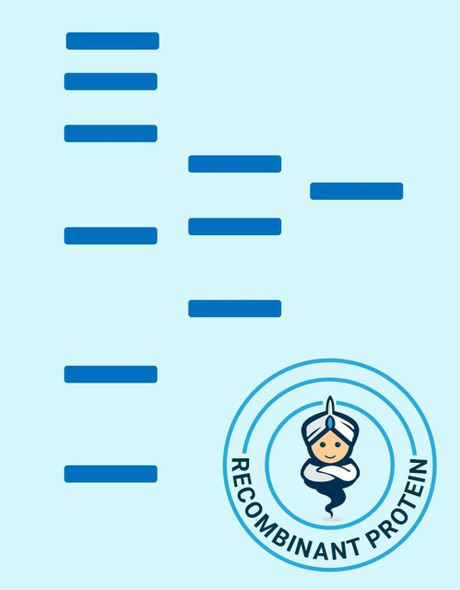Description
| Product Name: | Human KRT19 Recombinant Protein |
| Product Code: | RPPB3819 |
| Size: | 20µg |
| Species: | Human |
| Target: | KRT19 |
| Synonyms: | Keratin type I cytoskeletal 19, Cytokeratin-19, CK-19, Keratin-19, K19, KRT19, CK19, K1CS, MGC15366. |
| Source: | Escherichia Coli |
| Physical Appearance: | Sterile Filtered White lyophilized (freeze-dried) powder. |
| Formulation: | The protein (1mg/ml) was lyophilized after from a sterile solution containing 30mM Tris-HCl pH-8, 9.5M urea, 2mM DTT, 2mM EDTA and 10mM methylammonium chloride. |
| Solubility: | It is recommended to reconstitute the lyophilized KRT19 in sterile 18M?-cm H2O not less than 100�g/ml, which can then be further diluted to other aqueous solutions. |
| Stability: | Lyophilized KRT19 although stable at room temperature for 3 weeks, should be stored desiccated below -18°C. Upon reconstitution KRT19 should be stored at 4°C between 2-7 days and for future use below -18°C.For long term storage it is recommended to add a carrier protein (0.1% HSA or BSA).Please prevent freeze-thaw cycles. |
| Purity: | Greater than 95.0% as determined by SDS-PAGE. |
CTK-19 is a member of the keratin family. The keratins are intermediate filament proteins responsible for the structural integrity of epithelial cells and are subdivided into cytokeratins and hair keratins. The type I cytokeratins consist of acidic proteins which are arranged in pairs of heterotypic keratin chains. Unlike its related family members, this smallest known acidic cytokeratin is not paired with a basic cytokeratin in epithelial cells. It is specifically expressed in the periderm, the transiently superficial layer that envelopes the developing epidermis. The type I cytokeratins are clustered in a region of chromosome 17q12-q21.
Cytokeratin 19 Human Recombinant produced in E.Coli is a single, non-glycosylated polypeptide chain having a molecular mass of 44,098 Dalton. The KRT19 is purified by proprietary chromatographic techniques.
| UniProt Protein Function: | Function: Involved in the organization of myofibers. Together with KRT8, helps to link the contractile apparatus to dystrophin at the costameres of striated muscle. Ref.14 |
| UniProt Protein Details: | Subunit structure: Heterotetramer of two type I and two type II keratins. Interacts with PNN and the actin-binding domain of DMD. Interacts with HCV core protein. Ref.13 Ref.14 Tissue specificity: Expressed in a defined zone of basal keratinocytes in the deep outer root sheath of hair follicles. Also observed in sweat gland and mammary gland ductal and secretory cells, bile ducts, gastrointestinal tract, bladder urothelium, oral epithelia, esophagus, ectocervical epithelium (at protein level). Expressed in epidermal basal cells, in nipple epidermis and a defined region of the hair follicle. Also seen in a subset of vascular wall cells in both the veins and artery of human umbilical cord, and in umbilical cord vascular smooth muscle. Observed in muscle fibers accumulating in the costameres of myoplasm at the sarcolemma in structures that contain dystrophin and spectrin. Ref.2 Ref.4 Ref.14 Developmental stage: Present in hair follicles at all stages of development. Ref.4 Domain: This keratin differs from all other IF proteins in lacking the C-terminal tail domain. Miscellaneous: There are two types of cytoskeletal and microfibrillar keratin: I (acidic; 40-55 kDa) and II (neutral to basic; 56-70 kDa). Sequence similarities: Belongs to the intermediate filament family. |
| NCBI Summary: | The protein encoded by this gene is a member of the keratin family. The keratins are intermediate filament proteins responsible for the structural integrity of epithelial cells and are subdivided into cytokeratins and hair keratins. The type I cytokeratins consist of acidic proteins which are arranged in pairs of heterotypic keratin chains. Unlike its related family members, this smallest known acidic cytokeratin is not paired with a basic cytokeratin in epithelial cells. It is specifically expressed in the periderm, the transiently superficial layer that envelopes the developing epidermis. The type I cytokeratins are clustered in a region of chromosome 17q12-q21. [provided by RefSeq, Jul 2008] |
| UniProt Code: | P08727 |
| NCBI GenInfo Identifier: | 311033484 |
| NCBI Gene ID: | 3880 |
| NCBI Accession: | P08727.4 |
| UniProt Secondary Accession: | P08727,Q5XG83, Q6NW33, Q7L5M9, Q96A53, Q96FV1, Q9BYF9 Q9P1Y4, B2R874, |
| UniProt Related Accession: | P08727 |
| Molecular Weight: | 44,106 Da |
| NCBI Full Name: | Keratin, type I cytoskeletal 19 |
| NCBI Synonym Full Names: | keratin 19 |
| NCBI Official Symbol: | KRT19�� |
| NCBI Official Synonym Symbols: | K19; CK19; K1CS�� |
| NCBI Protein Information: | keratin, type I cytoskeletal 19; CK-19; keratin-19; cytokeratin 19; cytokeratin-19; keratin, type I, 40-kd; 40-kDa keratin intermediate filament |
| UniProt Protein Name: | Keratin, type I cytoskeletal 19 |
| UniProt Synonym Protein Names: | Cytokeratin-19; CK-19; Keratin-19 |
| Protein Family: | Keratin |
| UniProt Gene Name: | KRT19�� |
| UniProt Entry Name: | K1C19_HUMAN |






